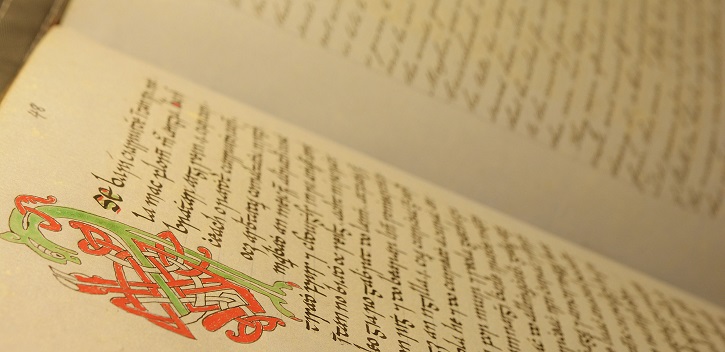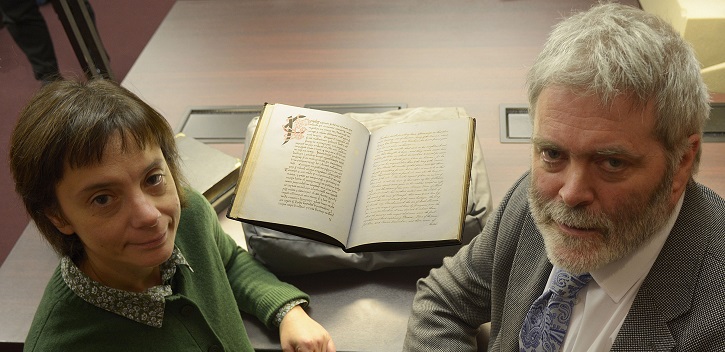From Arsenic to Zinc: UCC reveals chemistry of Gaelic manuscripts

Hidden away among the letters and words that cover the Gaelic manuscripts of the late middle ages is a world of minerals and chemical compounds.
These chemicals have their own tales to tell about the craft and ingenuity of the scribes.
Pigments and inks in the glorious gospel books of the age of the Celtic Church have been subjected to analysis over the past thirty years, most notably the Book of Kells. No such analysis has taken place on the manuscripts of the vernacular vellum and paper traditions of late-medieval Ireland, however.
This is now being addressed by research conducted by Prof. Pádraig Ó Macháin of the Dept of Modern Irish, UCC, in collaboration with Dr Daniela Iacopino and Dr Daniela Saviello of the Tyndall Institute, and with the cooperation of repositories such as the National Library of Ireland and the Royal Irish Academy.
In collaboration with XGLAB of Milan, preliminary XRF (x-ray fluorescence) analysis of a selection of Irish manuscripts from the period post-1100 has shown up the presence of a range of minerals on the pages of what might in some cases appear to be plain, bland books.
Commonest of the elements recorded is iron, a token of the pervasiveness of iron-gall ink as a writing material throughout Europe over many centuries. Calcium is also high on the list, being present in a number of areas, from the egg-white that was recommended as a simple binding in some ink-recipes, to the chalk that was used to reduce the greasiness of vellum skins. Another binding agent was gum arabic, and small traces of zinc have been found in both this and in the iron compound that formed another ink-ingredient, and either may account for the readings for that mineral that the study has thrown up. This is also true of copper, which, in addition to its presence in ink, is to be found in green pigments.
Red and yellow are the pigments most frequently used in the decoration of the letters in the manuscripts. At the most basic level this involves the European-wide practice of rubrication: highlighting notable words and individual letters in red, which often derived from red lead; but red was also derived from mercury-based pigments and both lead and mercury show in the manuscripts. Lead was also often used in creating the guidelines on the ruled manuscript pages.
Yellow occurs most commonly in the decoration of large letters at the beginning of texts or sections of texts. This yellow is likely to come from orpiment, a mineral compound of sulphur and arsenic. Both arsenic and sulphur are found on the manuscript pages. Sulphur also occurs in vermilion as does mercury.
Though only in its initial stages, the UCC research has already highlighted the exotic, and at times toxic infrastructure that lies beneath the work of the scribes of late medieval Ireland.
Ceimiceáin agus mianraí faoi cheilt ar leathanaigh na lámhscríbhinní Gaeilge
Tá scoláirí i gColáiste na hOllscoile, Corcaigh, i mbun taighde ar conas a cuireadh sean-lámhscríbhinní na Gaeilge le chéile agus ar na bunábhair ar baineadh leas astu chuige sin.

Tá, chomh maith, lámhleabhar ar pheannaireacht agus ar lámhscríbhinní na Gaeilge á scríobh ag an Machánach i bpáirt leis an Ollamh Tim O’Neill, mar áis do mhic léinn na Gaeilge.
Le déanaí tá togra nua curtha ar bun i gCorcaigh chun staidéar a dhéanamh ar na cineálacha dúigh a mbaintí leas astu i lámhscríbhinní na Gaeilge. Tá an taighde seo ar bun ag an Ollamh Ó Macháin i bpáirt le heolaithe ó Institiúid Náisiúnta Tyndall fé stiúir an Dra Daniela Iacopino. Cuid den gColáiste Ollscoile is ea Institiúid Náisiúnta Tyndall.
Mar chéim thosaigh tá scata de lámhscríbhinní na Gaeilge, ón 12ú haois go dtí an 17ú haois – sa Leabharlann Náisiúnta agus in Acadamh Ríoga na hÉireann – curtha fé ainilís x-gha ar mhaithe le suirbhé a dhéanamh a bheidh ina chabhair nuair a chuirfear tionscnamh níos mó agus níos leithne ar bun amach anso. Le maoiniú ó Enterprise Ireland a tugadh faoin dtogra beag seo.
Léiríonn an suirbhé seo go bhfuil roinnt mhaith ceimiceán agus mianraí faoi cheilt ar leathanaigh na lámhscribhinní Gaeilge, cuid acu nach rithfeadh le duine go mbeidís le fáil ina leithéid de rud agus leabhar lámhscríofa. Is é iarann an mianra is minicí a thagann chun solais mar gur bunábhar dúigh é. Faightear iarsmaí luaidhe agus sinc sa dúch uaireanta chomh maith. Bíonn cailciam forleathan sna lámhscribhinní meamraim go háirithe mar gur baineadh leas as cailc chun rian na hola a ghlanadh den gcraiceann; bíonn cailciam le fáil sa dúch sa chomh maith, nuair is gealacán uibhe a úsáideadh chun an lacht a tháthú, rud a tharla go minic. Cuid de na ceimiceáin, is leis an maisiú daite a cuireadh ar na litreacha a bhaineann siad: go háirithe an arsanaic, an sulfur agus an mearcair a fhaightear i leaganacha den dath buí a chítear go minic sna lámhscríbhinní Gaeilge. Maidir le haon dath glas a chítear sna sean-leabhair seo, is é an copar is bun leis de ghnáth.
Taighde é seo ar na lámhscríbhinní Gaeilge nach bhfuil a leithéid déanta in aon áit eile go dtí seo. Táthar ag coinne leis, de réir mar a fhoilseofar na torthaí, go gcuirfidh sé go mór lenár mbuneolas ar ghnéithe praiticiúla de chruthú na lámhscríbhinní agus ar na daoine a chruthaigh agus a scríobh iad chomh maith.
For more information about courses and research in the Department of Modern Irish visit here
For more information about UCC's Special Collections visit here
For more on this story contact:
Ruth Mc Donnell, Head of Media and PR, Office of Marketing and Communications, UCC Mob: 086-0468950
